Japan-Insights
Deepen your understanding of Japan’s people, places, and culture.
Stories
An Interview with Dr. Simon Kaner
Executive Director, Sainsbury Institute for the Study of Japanese Arts and Cultures
Nara to Norwich Project: Layered Tales of Identity from the Silk Roads
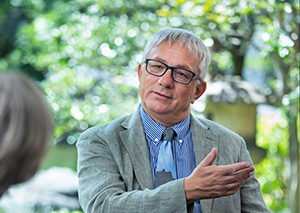
British archaeologist and Sainsbury Institute executive director Simon Kaner speaks with Japan-Insights about a robust Silk Roads curation project supported by TIFO.
Interview by Susan Rogers Chikuba
Writer’s Profile
Susan Rogers Chikuba
Susan has been following popular culture, architecture and design in Japan for three decades. As a Tokyo-based writer, translator and editor she covers the country’s art, design, literary and culinary scenes for domestic and international publications. She is a graduate of Cornell University.
It’s a complicated story, these living traditions, and so to be able to capture that complexity as part of what we’re doing, even a little bit, is really worthwhile.
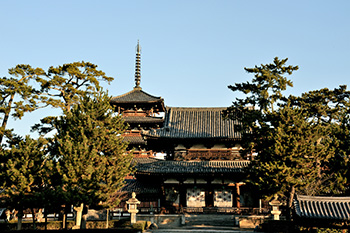
©Horyuji
Inspired by discoveries of silk in Anglo-Saxon and Viking graves, a sixth-century bronze Buddha at a Viking settlement in Sweden, Roman coins in medieval deposits in Okinawa, and evidence of Nestorian Christianity in Tang-dynasty China, a team of archaeologists and historians from Britain and Scandinavia traveled to Korea and Japan in 2019 for a series of workshops and field visits led by the Sainsbury Institute for the Study of Japanese Arts and Cultures (SISJAC). Supported by a grant from the Toshiba International Foundation (TIFO), those collaborative investigations were lead-up to a major exhibition then planned for late 2020 at the Sainsbury Centre art gallery and museum on the University of East Anglia (UEA) campus in Norwich, UK. The target date was postponed a few times with the onset of the pandemic, but the research continued and, since last June, much of the findings can now be enjoyed online.
SISJAC is a place of study renowned for its strengths in producing interdisciplinary research on Japan, and the exhibition is the brainchild of its executive director, Simon Kaner. Entitled Nara to Norwich: Art and Belief at the Ends of the Silk Roads, 500–1100, it examines how religions change and adapt, and the impacts that ensue, when different traditions of belief and ritual practice encounter one another. “We wanted to offer intellectual frameworks for understanding, in a comparative way, the processes through which Buddhism arrived and was adopted in Korea and Japan, and Christianity in Britain and Scandinavia—both in the sixth century, and at the extremities of Asia and Europe,” explains Kaner, an archaeologist himself whose passion is the prehistory of Japan.
What’s often referred to in the singular as the Silk Road is, in truth, not any one physical route but rather a catch-all concept for a vast geo-cultural space, mutable over time, that stretched across land and sea. Religion, art and knowledge were transmitted across this aggregation of trade, pilgrimage, and diplomatic networks through the centuries. By reassessing the historical and archaeological evidence for the spread of Buddhism and Christianity at either end of the Eurasian landmass—Nara, Japan to the east and Norwich, England to the west—Nara to Norwich aims to show just how far-reaching the effects of those interactions and encounters were. At the same time it is identifying new areas of research on intra-connections that are threaded through the cultures of Eurasia.
The work being done in Japan, for example with the Takamatsuzuka tomb in Asuka, Nara, is right at the cutting edge of conservation science. And it’s not just Japanese archaeology—the material is important for understanding the history of humanity altogether, no question about it.
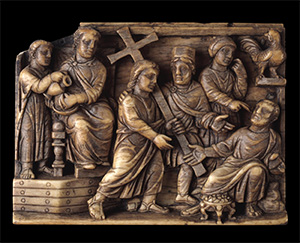
©The Trustees of the British Museum
“We’re finding commonalities and also some really interesting divergences, such as the ways in which older forms of belief were either accommodated or repressed, between the two extremities of Eurasia,” Kaner says. “Buddhism and Christianity are world religions that had traveled around—already been around—for a while before they arrived either in Korea and Japan, or over in England. So it’s about how ideas travel long distances, and what impact the arrival of those ideas has on communities.”
“The original plan,” Kaner continues, “was to borrow fairly widely from Japan, Korea, and various parts of Europe and the UK. Then the pandemic struck, and the project transitioned for the time being to the digital sphere, which has taken us in directions I never thought we would be exploring. But I have to say, we’re really proud of what we’ve accomplished, thanks to a lovely network of people made possible at the beginning with TIFO’s agreement to sponsor those initial workshops.”
The relationship between TIFO and SISJAC dates back to the Institute’s founding in 1999. The Nara to Norwich project met the requirements for grant support because it promotes international understanding of Japan while encouraging young scholars and strengthening connections among institutions around the world engaged in simpatico research.
This digital realm is a whole new world for us, and we were very fortunate to be able to use some of the Toshiba support to realize that.
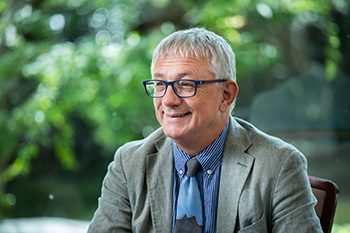
Nara to Norwich and its body of work exploring micro-histories of material culture, landscape, and literature went online in June 2022, and the content completed thus far is already a transcontinental treasure trove. In this first stage it presents 88 exhibits across the five main stories of “Origins,” “Arrivals,” “Encounters,” “Living in Belief,” and “Relics.” More themes, such as “Pilgrimage” and “Death and Burials,” will be uploaded as the research continues, with some 200 exhibits planned in all. These main galleries are supplemented by shorter, breakout treatments addressing a range of engaging topics. A few in development at the time of this writing consider, for example, how fragile glass objects journeyed over the Silk Roads, how medieval clergy wore their silks, and how the night sky appeared to navigators all those centuries ago. The digital Nara to Norwich also includes a full database of exhibits with object labels, and a blog to which project team members and international scholars working on the project contribute. Once the online presentation is complete, an array of in-person exhibits is planned for 2024 and beyond, including smaller shows at satellite sites in addition to the UEA campus. Kicking it all off will be a “Japan in Norwich” festival marking the 25th anniversary of SISJAC.
The research that’s being done in Japan and elsewhere doesn’t want to be buried away in a dossier. For me the question has been, “How do we bring this to life?”
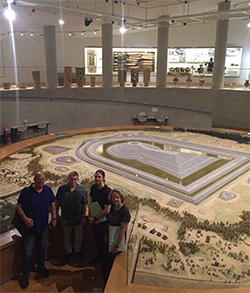
©Simon Kaner; courtesy of Osaka Pref. Chikatsu Asuka Museum
“We’ve got four ‘landscapes of conversion’ where Buddhism and Christianity were taking off,” Kaner says of the project’s inquiry into how beliefs were encountered and assimilated. “In Japan of course it’s the Asuka region centered on Nara, in Korea the kingdom of Baekje. It’s hard to imagine these landscapes. You can put up maps, but people’s eyes tend to glaze over. So we’re considering some kind of experiential installation—Sarah Kenderdine in Switzerland, for example, is doing amazing work in data visualization, and has digitalized one of the cave temples at Dunhuang in 1:1 scale. What I have in mind is four big screens on the wall, with our four landscapes of conversion, and maybe just two or three rare objects and incense, some chanting, some music—something sensorial like that.” A colleague at the Nara National Research Institute for Cultural Properties, Kaner says, is looking at the origins of incense and the scientific archaeology of whether traces of scent can be found in artifacts at the molecular level. “What we want is for people to walk through and think, ‘Oh, that’s a really interesting idea, I hadn’t thought about that.’ And then with QR codes and such we can point them to the appealing digital exhibition that they can stroll, or maybe scroll, through in the comfort of their own home.”
Kaner’s expertise in archaeology shows in the ease with which he connects the dots between research now underway at disparate locations. He has a ready supply of ideas for ways in which such findings might work together reflexively to tell a larger story. One such blue-sky sketch is to exhibit replicas of materials that have been excavated from Japan’s Fujinoki burial mound in Nara at the on-site museum of Sutton Hoo, the medieval Anglo-Saxon burial ground on the east coast of England. Rekindled in recent collective memory by the 2021 film The Dig, Sutton Hoo’s famous early-medieval ship burial site dates exactly to the time of the Fujinoki mound, and is part of a wider European tradition also seen in the royal mounds at Gamla Uppsala in Sweden. Common to all of these sites, and among pastoralist peoples across the Eurasian Steppe, are the same techniques of gold work inlaid with garnets that likely originated in South Asia. Additionally, some of the iconography from the Sutton Hoo dig is in the shape of a cross, pointing to the Christian faith that had traveled from West Asia, while certain elements of the Fujinoki iconography hail from Korea and China. Showing such exhibits in tandem, Kaner and his colleagues believe, can point to deeper insights in a myriad of ways: how religions gave rise to new forms of monumentality in burial practices and architecture, how they were embodied in state formation, and even how they influenced the gendering of religious experience in monasticism and the clergy.
A further idea is to collaborate with Swedish colleagues to show the Fujinoki materials together with such finds as the Helgö Buddha, a tiny figure sitting on a lotus flower and likely made in the late sixth century in the Swat Valley of current-day Pakistan. It’s believed to have been carried thousands of miles over the rivers and steppes of Eurasia to wind up, by the eighth century, on the mantelpiece of a Viking home in Sweden. A desire to fathom its story has long been part of the inspiration behind Nara to Norwich. “I’m enjoying these kinds of ideas,” Kaner beams, “deconstructing what we’ve accomplished thus far and determining how to get it out to a wider range of different places.”
When you’re a student, to come upon somebody in the field who knows all about what you’ve only seen in books or on slides can be a life-changing experience. I’d love to offer as much of that as we can, moving forward.
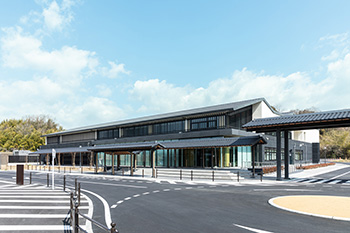
©Natsumi Kinugasa; courtesy of Nara Prefecture Historical and Artistic Culture Complex
Yet another possibility Kaner dreams of realizing is a joint event in Japan at the Nara Prefecture Historical and Artistic Culture Complex—a michinoeki road stop and service area where the restoration of cultural properties has gone public. “What they’ve done—I just think it’s amazing, it’s so visionary. You know, michinoeki showcase local products and that sort of thing. Well, Nara is famous for its Buddhist statues. So they’ve tied up with a consortium of universities and are actually restoring and conserving Buddhist artworks right there, for anyone to see. You go in, you go downstairs, and there they are at work behind glass. I thought that’s just incredible—what a wonderful thing to do.” Kaner expressed his desire that some elements of Nara to Norwich might be shown at the complex, perhaps in 2025 around the time of the Osaka Expo.
It’s all research-based, we’re generating new research, and there’ll continue to be more.
Eventually, perhaps in 2026 or 2027, a book will be published. “By then we will have done the exhibition, done all of the research, and have gotten some academic papers out,” Kaner offers. Nara to Norwich is, in a way, its own geo-cultural space—an evolving framework through which we can try to order our inquiries into times and places of the past. Discoveries of silk and Buddhist images in northern Europe paint a picture of a far-reaching global network of transmissions by monks, missionaries, merchants, and emissaries. Such artifacts demonstrate that, far from living in isolation, peoples of ancient and medieval times across Eurasia were more connected and aware of a wider world than we often assume. Unburying these wider historical links, holding them up to the light, we might see in our ancestors’ layered networks and identities an ontology of connection that is deeply needed today.
For now, the site is up for all to explore, and the research continues. In early 2023, the Nara to Norwich team plan to convene with Japan on the Silk Road editor Selçuk Esenbel and scholars from Japan and abroad at a conference in Istanbul. There they will discuss issues of transnationality in regard to Japan’s intellectual and political encounters with peoples and cultures along the Silk Roads, including Turks and Persians, Hindus and Muslims of India, Mongolians and Uyghurs of Inner Asia, and Muslims in China.


